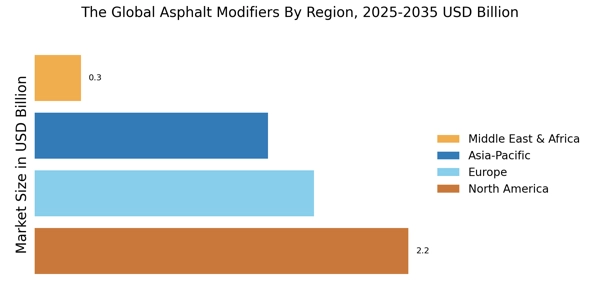Rising Demand for Durable Pavements
The increasing demand for durable pavements is a primary driver for The Global Asphalt Modifiers Industry. As urbanization accelerates, the need for long-lasting road surfaces becomes critical. Asphalt modifiers enhance the performance of asphalt mixtures, improving their resistance to cracking and deformation. This is particularly relevant in regions experiencing heavy traffic loads. According to recent data, the market for asphalt modifiers is projected to grow at a compound annual growth rate of approximately 5.2% over the next few years. This growth is driven by the necessity for infrastructure that can withstand extreme weather conditions and heavy vehicular traffic, thereby extending the lifespan of roadways and reducing maintenance costs.
Government Regulations and Standards
Government regulations and standards play a pivotal role in shaping The Global Asphalt Modifiers Industry. Many countries are implementing stringent regulations aimed at improving road safety and environmental sustainability. These regulations often mandate the use of modified asphalt in road construction and maintenance projects. For instance, the adoption of performance-based specifications encourages the use of high-quality asphalt modifiers to meet specific performance criteria. This trend is likely to drive market growth as manufacturers seek to comply with these regulations while also enhancing the quality of their products. The increasing focus on sustainable construction practices further emphasizes the importance of using advanced asphalt modifiers.
Expansion of Road Infrastructure Projects
The expansion of road infrastructure projects is a crucial driver for The Global Asphalt Modifiers Industry. Many countries are investing heavily in upgrading and expanding their road networks to accommodate growing populations and economic activities. This investment is often accompanied by the need for high-performance asphalt that can withstand increased traffic volumes. The demand for asphalt modifiers is likely to rise as these projects require materials that enhance the durability and longevity of road surfaces. Recent reports indicate that infrastructure spending is expected to increase significantly, which will likely boost the demand for asphalt modifiers. This trend presents opportunities for manufacturers to supply innovative solutions that meet the evolving needs of the construction industry.
Technological Innovations in Asphalt Production
Technological innovations in asphalt production are significantly influencing The Global Asphalt Modifiers Industry. Advances in polymer technology and the development of new additives have led to the creation of superior asphalt products. These innovations not only improve the performance characteristics of asphalt but also enhance its resistance to environmental factors. For example, the introduction of warm mix asphalt technology allows for lower production temperatures, reducing energy consumption and emissions. This shift towards more efficient production methods is expected to attract investments in the asphalt modifiers sector, potentially increasing market share. The integration of smart technologies in asphalt production processes may also lead to improved quality control and product consistency.
Growing Focus on Sustainable Construction Practices
The growing focus on sustainable construction practices is a significant driver for The Global Asphalt Modifiers Industry. As environmental concerns rise, there is an increasing demand for eco-friendly materials in construction. Asphalt modifiers that incorporate recycled materials or reduce carbon footprints are gaining traction. This trend aligns with global sustainability goals and encourages manufacturers to innovate and develop greener products. The market for sustainable asphalt modifiers is expected to expand as more construction projects prioritize environmental impact. Furthermore, the use of sustainable materials can lead to cost savings in the long run, making it an attractive option for contractors and developers.


















Leave a Comment